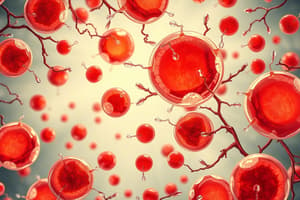Podcast
Questions and Answers
What is the main component of plasma according to the text?
What is the main component of plasma according to the text?
- Only neutral particles
- Only anions
- Only cations
- Ions and neutral particles (correct)
What is the charge of cations in plasma?
What is the charge of cations in plasma?
- Variable charge
- No charge
- Negative charge
- Positive charge (correct)
Which process maintains the balance between ions and neutral particles in plasma?
Which process maintains the balance between ions and neutral particles in plasma?
- Particle fusion
- Ion bonding
- Charge exchange (correct)
- Electron donation
What role do neutral particles play in plasma?
What role do neutral particles play in plasma?
Which property of plasma allows it to conduct electricity effectively?
Which property of plasma allows it to conduct electricity effectively?
What aspect of plasma makes it highly responsive to changing conditions?
What aspect of plasma makes it highly responsive to changing conditions?
Why does plasma flow easily compared to other states of matter?
Why does plasma flow easily compared to other states of matter?
What is the main component of plasma that is responsible for its electrical properties?
What is the main component of plasma that is responsible for its electrical properties?
Which technology does NOT involve the use of plasma?
Which technology does NOT involve the use of plasma?
What is the role of neutral particles in maintaining the overall charge balance of plasma?
What is the role of neutral particles in maintaining the overall charge balance of plasma?
Flashcards are hidden until you start studying
Study Notes
The Main Component of Plasma: Ions and Neutral Particles
Plasma, a fourth state of matter alongside solid, liquid, and gas, is a dynamic and abundant form of the universe. It is a sea of charged particles that intertwines with our daily lives, from the glow of neon signs to the workings of the Sun. So, what exactly comprises this swirling dance of energy and particles?
Ions
The main component of plasma is ions. These are atoms or molecules that have gained or lost one or more electrons, resulting in a positive or negative charge. In plasma, there are roughly equal numbers of positive and negative ions, canceling each other out and leaving the overall charge on the plasma as a whole neutral.
Two types of ions are commonly found in plasma:
- Cations: Positively charged ions, formed when an atom loses one or more electrons.
- Anions: Negatively charged ions, formed when an atom gains one or more electrons.
Neutral Particles
In addition to ions, plasma also contains neutral particles. These are atoms or molecules that have not gained or lost any electrons, and therefore, have no overall charge. In plasma, neutral particles serve as a reservoir of electrons, constantly donating or accepting free electrons to balance the charge of ions.
Equilibrium in Plasma
The balance between ions and neutral particles in plasma is maintained by a process called charge exchange. In charge exchange, an ion and a neutral particle collide, transferring an electron between them. This process ensures that both positive and negative charges are equally distributed, keeping the overall charge of the plasma as a whole neutral.
Plasma's Properties
The combination of ions and neutral particles gives rise to unique properties of plasma. Some of these properties include:
- Plasma's high temperature and low density allow it to conduct electricity, making it an excellent medium for maintaining electrical balance and power transmission.
- Plasma's ability to be easily ionized and recombined makes it highly responsive to changing conditions, such as temperature, pressure, and magnetic fields.
- Plasma's dynamic state and low viscosity allow it to flow easily, making it useful for processes like fusion energy production and propulsion systems.
Applications of Plasma
Plasma is involved in a wide variety of technologies and applications, including:
- Fluorescent lighting
- Lasers
- Electronic displays
- Plasma etching in semiconductor manufacturing
- Plasma thrusters and electric propulsion
- Fusion energy
Conclusion
The main component of plasma is a mix of ions and neutral particles. Ions, with their charged nature, are responsible for the electrical properties of plasma, while neutral particles maintain the overall charge balance. The unique properties of plasma have led to its widespread application in various technologies, from LED screens to fusion energy production. So next time you see a neon sign glowing bright, remember the ions and neutral particles that make up the plasma behind it. is not relevant to this topic.
Studying That Suits You
Use AI to generate personalized quizzes and flashcards to suit your learning preferences.




